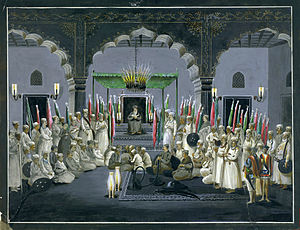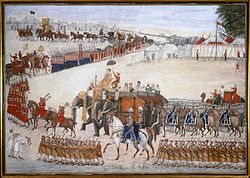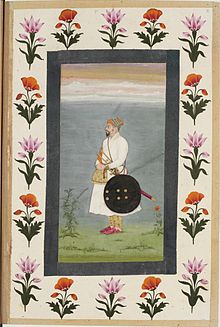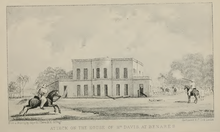- Mansabdar
-
Mansabdar was the generic term for the military -type grading of all imperial officials of the Mughal Empire. The mansabdars governed the empire and commanded its armies in the emperor's name. Though they were usually aristocrats, they did not form a feudal aristocracy, for neither the offices nor the estates that supported them were hereditary.
The term is derived from Mansab, meaning 'rank'. Hence, Mansabdar literally means rank-holder.
Contents
History
The Mughals ruled India from 1526 AD, when Babur defeated Ibrahim Lodi at the Battle of Panipat, till 1707 AD when the Emperor Aurangzeb died and thereafter nominally till the Indian Rebellion of 1857.
When Babur invaded India to establish his kingdom his army consisted of tribes and clans that followed him from Kabul, some joined him later, after the Battle of Panipat, he awarded the leaders of these tribes and clans in accordance to their performance in the battle and many of them who had joined Babur for the booty, chose to return to their homes.
Babur and Humayun ruled over territory that was not too far flung. After the tribes and the clans that had joined Babur for booty returned after the Battle of Panipat, their place was taken by foreign adventurers, Uzbeks, Persians, Arabs, Turks etc who thronged to the court with contingents of troops. Since the Mughals were foreigners there were no hereditary nobles related to the rulers or ancient families to depend upon, the court consisted of adventurers from different nations, the ruler raised them to dignity or degraded them; up to the early rule of Akbar the Mughal armies consisted of contingents commanded by these adventurers.
Akbar, Babur’s grandson, who ruled from 1556 to 1605, organized the ‘mansabdari’ system in the 19th year of his rule. The system classified the functionaries of the kingdom as fighters, ‘ashab-u’s-saif’, (masters of the sword); clerks ‘ashab-u’l-qalam’ (masters of the pen); theologians, ‘ashab-u’l-amamah’. The ‘mansab’ denoted a rank of office, it had its obligations, precedence and grade of pay; it was for life but it was not hereditary, heirs could not demand continuity of office.
The status of the ‘ashab-u’s-saif (military) and ashab-u’l-qalam’ (clerical and administrative), was denoted by military rank, originally 66 grades but later only 33 grades existed. Every official of the empire above the rank of a sepoy or a servant held an army rank, the lowest was the commander of twenty; the highest the commander of seven thousand.
Ranking of Mansab
Mansabs were ranked as of 7,000, 6,000, 5,000, intervals of 500 between 5,000 and 1,000, intervals of 100 between 1,000 and 200, intervals of 50 between 200 and 100, finally intervals of 20 between 100 and 20.
Mansabs were of three classes, 7,000 to 3,000 - ‘Amir-i-Azam’ the greater nobles; 2,500 to 500 - ‘Amir’, noble; 400 to 20 - ‘Mansabdar’ office holder. Commanders of higher ranks were of three classes according to the proportion of horsemen, first class if the whole command was of ‘horse’, second class if the ‘horse’ element was more than half and third class if less than half.
Compensation per annum started at rupees 350,000 with intervals of 50,000 between mansabs of 7,000 and 5,000; rupees 250,000 with intervals of 25,000 between mansabs of 5,000 and 1,000; the mansab of 20 received 1,000.
Compensation was either ‘naqdi’ meaning cash compensation or by the revenue of a ‘jagir’, an area of land which was not given to the ‘mansabdar’ but he could use the revenue from the land for his expenses and compensation. The ‘mansab’ could be increased or decreased on the wishes of the ruler and reports of performance and two lists were maintained, ‘Hazir-i-rikah’ present at court and ‘Ta-inat’ on duty elsewhere.
For a military mansab an application could be made for a mansab with troops or without troops. Those applying for a mansab with troops brought their retainers, mounted and equipped at their expense, these were known as ‘silladars’ and their men were known as ‘bagirs’. (The system continued under the British till 1914.) When a silladar brought his men, they were paraded for inspection, their descriptive rolls were prepared and the horses were branded; these mansabdars were paid for the maintenance of horses and the salaries of the men. Men considered fit to command but lacking resources were given money to purchase horses and received the salaries of the men only. Men who could not be mansabdars but too good to be employed as soldiers were given the higher rank of a ‘ahadi’.
Military mansabdars were required to maintain troops according to the mansab including beasts of burden, elephants, camels, mules, carts etc, they maintained horses for their troopers and a prescribed number in their own stables.
The Mansabdars got their cavalrymen(horse riders) for review, their horses branded [DAG or CHEHRA)and got them registered with each and every detail (description role of the horse known as (HULIA)]
Military command was at the will of the emperor, Akbar held that anyone could be a military commander and often appointed commanders who had no military knowledge or experience.
Jagir was a piece of land held by the mansabdar which was granted by the Sultan.
Mansabdars were given control over an area of land, a ‘jagir’ whose revenue was to be used for maintaining troops; if not given a ‘jagir’ they were paid in cash through a complicated accounting system, with deductions for various things including ‘the rising of the moon’; it was a normal practice to pay for only eight or ten months in the year. The mansabdars were allowed to keep five percent of the income of the ‘jagir’ or five per cent of the salaries received. The accounting system was complex, mansabdars usually borrowed money for expenses and when they died their private property was seized against any outstanding balances.
With a corrupt system of accounting and inspection very few mansabdars kept their units up to strength. When a mansabdar was ordered to take part in an expedition, he was required to parade his unit outside the palace and the emperor inspected it from a window in the palace.
Cavalry made up the bulk of the Moghal army; they enjoyed the prestige of warriors. Individual troopers took great care to keep themselves fit, they exercised, engaged each other in mock fights, practiced horsemanship, they were personally brave and trained themselves for person to person combat, but were unwilling to endanger their mounts because their salary depended on these; there was no training for units to act collectively.
Infantry was despised as drudges, they were considered little more than watchmen to guard the baggage, laborers, porters etc. The infantry consisted of matchlock men and archers, in the ratio of one matchlock man to four archers because of the greater rate of fire of the archers since both weapons had about the same effective range; there was no infantry training, no discipline and very little reliance was placed on them.
The ‘Mir Atish’, the ‘master gunner’, was responsible for the manufacture, supply of ordnance and was the artillery commander. Gunners were called ‘golandaz’ (the bringer of round shot, a term also used by the British till 1857), they were paid directly from the treasury and were the most reliable part of the army. The efficiency of the Moghal artillery was poor, the rate of fire was very low and the pieces were difficult to move. Europeans as artillerymen were prized and were paid as much as ten times the amount paid to locals.
The recruitment of men was by ‘classes’; it was specified that an officer from Iran could not recruit more than one third Moghals, the rest had to be Syeds or Sheikhs, Afghans could not be more than one sixth or Rajputs more than one seventh of a force. The British adopted this system of recruitment by ‘classes’.
The Moghal army consisted of bands of horsemen, each band linked by some personal loyalty to its leader but without any loyalty to the emperor or any national or religious loyalty. These soldiers of fortune depended on their commanders; their pay was always kept in arrears to prevent desertion.
There was a theoretical pattern to which the army conformed in battle; this consisted of three divisions, the center, right and left wing, each of these had an advance guard, a screen of skirmishers and there was a rear guard to the whole force. Once a formation was adopted there was very little capability for maneuver and there was no system of communicating between the parts.
Open country was necessary for successful action by a Moghal army because it was mostly cavalry. The opposing armies deployed guns on a line protected by earthwork and tied together with chains or ropes to prevent cavalry riding through as Babur had done at Panipat. Battle started with artillery fire, the heavy guns fired one round every three hours while the others about four rounds per hour. When it was considered that the artillery had sufficiently demoralized the enemy, successive charges were delivered from one wing then the other; the cavalry first fired their matchlocks and arrows then closed with the sword, spear and the mace, fighting was series of skirmishes ending in individual combat. The cavalry was not trained to act collectively on command, once dispersed it could not be formed again but since cavalry was the bulk of the army, the object of the Moghal commander was to engage the enemy on an open plain where he could deliver a massed charge of mail clad warriors. Up to the time of Aurangzeb, the Moghals fielded much larger armies than their opponents and usually managed to defeat their enemy, either on the battlefield or after a siege.
During battle the overall commander or the king had to prominently show his presence on the battlefield, usually riding an elephant, the battle objective was usually the elephant of the opposing commander and around it raged the fiercest battle; the decisive event of a battle was the death or disappearance of the leader, if he was known to have been killed or could not be seen the troops dispersed and sought their own safety. Aurangzeb when fighting his brothers for succession, in two battles, the rival to the throne was induced by treacherous advice to dismount and their armies automatically dispersed; this was because the remuneration of the army was from individual princes. The British used this custom to their advantage by knocking off the commanders with a four-pounder artillery piece and causing the dispersion of the opponents, eventually the princes and commanders learnt to ride horses instead of elephants and not to prominently show themselves.
The Emperor usually did not personally command the army unless it was a very large force in an important campaign; when the army moved out to war with the emperor in command, the whole apparatus of government moved with it. Aurangzeb’s army on the move included camels bearing treasure, one hundred loaded with gold, two hundred with silver; the emperor’s hunting establishment, with hawks and cheetahs; official records, on eighty camels, thirty elephants and twenty carts, these could never be parted from the emperor; a hundred camels carried water and kitchen utensils; fifty milch-cows, a hundred cooks, each a specialist in a dish; fifty camels and a hundred carts carried the emperor’s and his ladies wardrobe; thirty elephants carried the women’s jewellery and presents for successful commanders.
The mass of the cavalry, the main strength of the army, led, then the way was leveled for the emperor and his women; a rear guard largely of infantry brought up the tail. When the army halted the emperor’s camp was about a mile long, a square enclosure was roped off and surrounded by a ditch, heavy artillery defended the approaches, the emperor’s tent was in the center, divided into four courts with the entrance facing the direction of the next day’s march.
The army transport consisted of elephants, camels, packhorses, bullocks, bullock carts and porters. Every man provided for himself by buying for his needs, on a daily basis from ‘banyas’ who erected their shops in the camps. Supplies of grain were brought to the camp by ‘banjarahs’ on bullocks, which moved at two miles an hour, they formed a square in the evening with bags of grain. Either side did not attack the ‘banjarahs’ and the grain taken was paid for. Fodder was taken from the countryside and foragers looted the villages in the path of the army.
The armies of the Moghal times consisted of bands without military training and discipline; there was no loyalty owed to the ruler or the state; band leaders could be bought; half hearted support during battle, treachery and desertion were therefore negotiable. The two opposing armies would camp on the battlefield and for several days negotiations would be conducted to entice commanders to change sides before the battle, to refuse to act at a critical moment or to desert with their commands during a battle. The British successfully exploited this mercenary soldiering, in its worst form, when they fought the princes who had seized bits and pieces of the Moghal Empire.
Insulated by the mountains and the seas, the Moghals developed a military system which, though locally successful, did not improve on the weapons, organization and tactics, failed miserably when it clashed with the European military system of the period. Instituted by the Mughal emperor Akbar, mansabdari was a system common to both the military and the Civil department. Basically the Mansabdari system was borrowed from Persia. It was prevalent during the reign of Babur and Humayun. Akbar made some important changes to the system and made it more efficient. Mansabdar was referred to as the official, rank, or the dignity.
Two grades delineated the mansabdars. Those mansabdars whose rank was one thousand
Zat and Sawar
The Mansabdars were differentiated by the Zat and the Sawar Rank. The Zat referred to the number of troops maintained by the mansabdar and the Sawar referred to the number of horses maintained by the mansabdar. It was dependent on whether the king ordered the mansabdar to maintain more horses than his rank. The categories are shown below:
-No. of Sawar = No. of Zat => 1st Class Mansabdar
-No. of Sawar = 1/2 the No. of Zat => 2nd Class Mansabdar
-No. of Sawar < 1/3 the No. of Zat => 3rd Class Mansabdar
A Mansabdar was in the service of the state and was bound to render service when asked. Additionally, they were graded on the number of armed cavalrymen, or sawars, which each had to maintain for service in the imperial army. Thus all mansabdars had a zat, or personal ranking, and a sawar, or a troop ranking. All servants of the empire, whether in the civil or military departments were graded in this system. There were thirty-three grades of mansabdars ranging from 'commanders of 10' to 'commanders of 10,000'. Till the middle of Akbar's reign, the highest rank an ordinary officer could hold was that of a commander of 5000; the more exalted grades between commanders of 7000 and 10,000 were reserved for the royal princes. During the period following the reign of Akbar, the grades were increased up to 20,000 or even more generally rs.20-25 per horse were paid to a mansabdar.
Appointment, promotion, suspension or dismissal of mansabdars rested entirely with the emperor. No portion of a mansabdar's property was hereditary, a mansabdar's children had to begin life anew. A mansabdar did not always begin at the lowest grade. The emperor, if satisfied, could and did grant higher or even the highest grade to any person. There was no distinction between civil and military departments. Both civil and military officers held mansabs and were liable to be transferred from one branch of the administration to another. Each mansabdar was expected to maintain prescribed number of horses, elephants, equipment, etc., according to his rank and dignity. These rules, though initially strictly enforced, were later slackened.
Senior mansabdars were awarded a jagir (personal fief) rather than a salary. Rates of remuneration, which included both the mansabdar's salary and so much per sowar, were matched by jagirs affording a similar aggregate yield. If their specified yield came to more, the surplus was due to the imperial treasury; if the jagirdar extracted more than the specified yield, he kept it. Any other info.. can link into anyother
See also
- Mughal Empire
- Akbar
- Aurangzeb
- Afzal Khan
- Subedar
- Sawar
- Sepoy
- Hyder Ali
- Mughal weapons
References
Categories:- Feudalism
- Titles in India
- Feudalism in Pakistan
- Mughal Empire
- Indian feudalism
Wikimedia Foundation. 2010.




